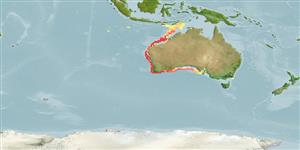Classification / Names
Common names | Synonyms | Catalog of Fishes (gen., sp.) | ITIS | CoL | WoRMS | Cloffa
Elasmobranchii (sharks and rays) >
Carcharhiniformes (Ground sharks) >
Triakidae (Houndsharks) > Triakinae
Etymology: Mustelus: Latin, mustela, -ae = weasel (Ref. 45335); stevensi: Named for Dr. John Stevens, CSIRO.. More on author: Last.
Environment / Climate / Range
Ecology
Marine; benthopelagic; depth range 121 - 402 m (Ref. 76951). Tropical, preferred ?
Eastern Indian Ocean: Australia.
Length at first maturity / Size / Weight / Age
Maturity: Lm ?, range 58 - 91.9 cm
Max length : 91.9 cm TL male/unsexed; (Ref. 76951); 103.4 cm TL (female)
Short description
Morphology | Morphometrics
A relatively large species with the following set of characters: moderately tall dorsal fins, posterior margin mostly upright distally, the first dorsal-fin base length is 1.6-2.1 times anal-caudal space; buccopharyngeal denticles cover the entire palate and floor of mouth; long claspers of adult males are slender, strongly depressed, inner length about 8-11% TL, reaching to level of second dorsal-fin origin; the lower edge of spiracle usually at level with lower edge of eye; anal-fin insertion is slightly anterior to its apex; about 72/75 teeth rows; 76-80 precaudal vertebral centra; 33-35 monospondylous centra; dorsal color light yellowish grey with numerous small, diffuse-edged white spots in staggered, irregular rows on postspiracular head and body; the light and dark tonal coloration are not well demarcated; bases and inner lobe of dorsal fins of juveniles (<400 mm TL) whitish and strongly contrasted to distal part of fin; juveniles’ caudal fin not distinctly white-edged (Ref. 76951).
Life cycle and mating behavior
Maturity | Reproduction | Spawning | Eggs | Fecundity | Larvae
White, W.T. and P.R. Last, 2008. Description of two new species of gummy sharks, genus Mustelus (Carcharhiniformes: Triakidae) from Australian waters. pp. 189-201. In P.R. Last, W.T. White and J.J. Pogonoski (eds). Descriptions of new Australian chondrichthyans. CSIRO Marine and Atmospheric Research Paper no. 22. 365 p. (Ref. 76951)
IUCN Red List Status (Ref. 115185)
CITES (Ref. 94142)
Not Evaluated
Threat to humans
Harmless
Human uses
More information
Age/SizeGrowthLength-weightLength-lengthLength-frequenciesMorphometricsMorphologyLarvaeLarval dynamicsRecruitmentAbundance
ReferencesAquacultureAquaculture profileStrainsGeneticsAllele frequenciesHeritabilityDiseasesProcessingMass conversion
Tools
Special reports
Download XML
Internet sources
